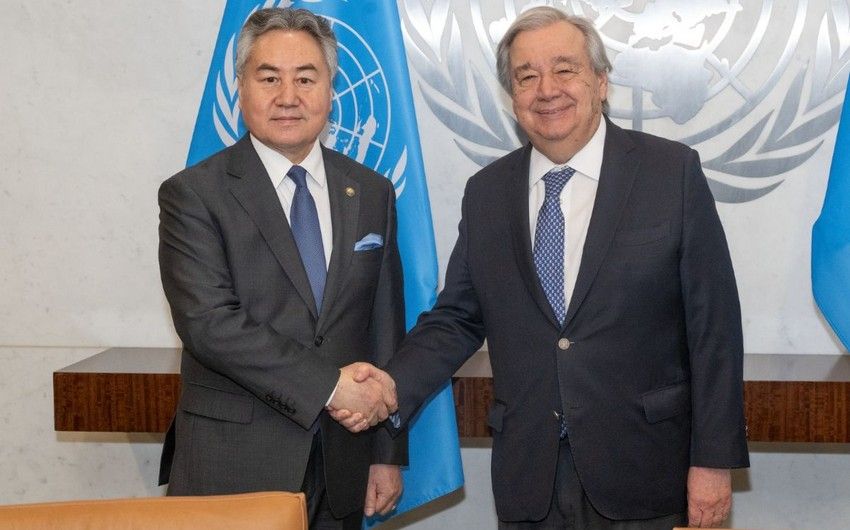Kyrgyzstan Sees Continued Growth in Foreign Direct Investment – The Times Of Central Asia

Foreign Direct Investment in Kyrgyzstan: A Catalyst for Sustainable Development
FDI Performance and Contribution to Economic Growth (SDG 8)
Kyrgyzstan is demonstrating significant progress in attracting Foreign Direct Investment (FDI), a key driver for achieving SDG 8: Decent Work and Economic Growth. The nation’s ability to secure investment has surpassed pre-pandemic levels, fostering sustained economic activity and job creation.
- Total FDI in 2024 exceeded $1 billion, indicating robust economic health.
- In the first quarter of 2025, FDI inflow reached $288.3 million, a 44% increase compared to the same period in 2024.
Strengthening Global Partnerships for Sustainable Development (SDG 17)
The diverse origins of FDI underscore Kyrgyzstan’s commitment to SDG 17: Partnerships for the Goals. The country has successfully cultivated investment relationships with a broad spectrum of international partners from both Commonwealth of Independent States (CIS) and non-CIS countries.
Top Foreign Investors, Q1 2025
- China: $66.3 million
- Turkey: $62.0 million
- Russia: $56.0 million
- Kazakhstan: Nearly $50.0 million
- Netherlands: $23.8 million
Investment in Industry, Innovation, and Infrastructure (SDG 9)
FDI is predominantly channeled into sectors crucial for SDG 9: Industry, Innovation, and Infrastructure. This strategic allocation of capital promotes sustainable industrialization, enhances productive capacity, and modernizes the nation’s economic base.
- Manufacturing: The primary recipient of foreign investment, including significant contributions from Turkey ($62 million).
- Financial Intermediation and Insurance: A key sector for facilitating economic activity.
- Other Key Sectors: Additional capital is being directed towards mineral extraction, trade, and equipment repair services.
Promoting Regional Development and Reducing Inequalities (SDG 10)
The geographic distribution of investment reflects efforts toward balanced regional development, a component of SDG 10: Reduced Inequalities. While the capital remains a central hub, investment is expanding into other regions, supporting local economies.
- Bishkek: The leading destination for foreign capital, attracting over $525 million in 2024.
- Chui Region: The second-largest recipient, with investment focused on the expansion of factories and processing enterprises.
Peace, Justice, and Strong Institutions as a Foundation for Investment (SDG 16)
Recent diplomatic achievements have translated into strengthened economic ties, illustrating how SDG 16: Peace, Justice, and Strong Institutions creates a stable environment for investment. Furthermore, emerging partnerships highlight a broadening of Kyrgyzstan’s global economic integration in line with SDG 17.
- Uzbekistan: Following a bilateral agreement on border demarcation, investment surged from $237,000 in all of 2024 to over $5 million in Q1 2025.
- India: Investment increased nearly 2,000%, from $91,000 in 2024 to $1.9 million in the first three months of 2025.
SDGs Addressed in the Article
SDG 8: Decent Work and Economic Growth
- The article’s central theme is the significant increase in Foreign Direct Investment (FDI) in Kyrgyzstan, which is a key driver for economic growth. The text states that FDI reached over $1 billion in 2024 and continued to show a positive trend in 2025, directly contributing to the country’s economic expansion.
SDG 9: Industry, Innovation and Infrastructure
- The article highlights that the “manufacturing sector continues to be the primary target for foreign investment,” followed by the “expansion of factories and processing enterprises.” This focus on industrial development and investment in production sectors directly aligns with the goal of promoting sustainable industrialization.
SDG 17: Partnerships for the Goals
- The text details the mobilization of financial resources from a diverse range of international partners. It explicitly names countries like China, Russia, Kazakhstan, Turkey, the Netherlands, Uzbekistan, and India as sources of FDI. The mention of a “bilateral agreement” with Uzbekistan further underscores the role of partnerships in achieving development goals.
Specific SDG Targets Identified
-
Target 8.1: Sustain per capita economic growth
- The article supports this target by reporting substantial FDI inflows, which are crucial for stimulating economic activity. The figures provided, such as FDI reaching “over $1 billion in 2024” and a “44% [increase] compared to the same period in 2024,” indicate strong momentum towards sustained economic growth.
-
Target 9.2: Promote inclusive and sustainable industrialization
- This target is addressed through the specific mention of investment allocation. The article states that the “manufacturing sector continues to be the primary target for foreign investment” and notes the “expansion of factories and processing enterprises,” which are direct contributions to building the country’s industrial capacity.
-
Target 17.3: Mobilize additional financial resources for developing countries from multiple sources
- The entire article serves as a case study for this target. It quantifies the financial resources mobilized through FDI, stating that Kyrgyzstan attracted “$288.3 million in direct investment” in the first quarter of 2025 alone. It also breaks down these resources by source, listing contributions from CIS and non-CIS countries, thereby demonstrating mobilization from “multiple sources.”
Indicators for Measuring Progress
-
Indicator for Target 17.3 (and related to Target 8.1): Foreign Direct Investment (FDI) Inflows
- The article directly provides quantitative data that can be used as an indicator for measuring progress. This is aligned with the official SDG indicator 17.3.1, which includes FDI. Specific data points mentioned are:
- Total FDI in 2024: Over $1 billion.
- Total FDI in Q1 2025: $288.3 million.
- FDI from China in Q1 2025: $66.3 million.
- FDI from Russia in Q1 2025: $56 million.
- FDI from Kazakhstan in Q1 2025: Nearly $50 million.
- The article directly provides quantitative data that can be used as an indicator for measuring progress. This is aligned with the official SDG indicator 17.3.1, which includes FDI. Specific data points mentioned are:
-
Implied Indicator for Target 9.2: Investment in Manufacturing and Industrial Sectors
- While not a formal SDG indicator, the article provides data that can be used to track progress towards industrialization. It states that the “manufacturing sector continues to be the primary target for foreign investment” and that Turkey invested “$62 million in Kyrgyzstan’s production sector.” This flow of capital into industrial sectors is a clear measure of progress towards Target 9.2.
Summary Table of SDGs, Targets, and Indicators
| SDGs | Targets | Indicators |
|---|---|---|
| SDG 8: Decent Work and Economic Growth | Target 8.1: Sustain per capita economic growth in accordance with national circumstances. | Total volume of Foreign Direct Investment (FDI) as a driver of economic growth (e.g., over $1 billion in 2024). |
| SDG 9: Industry, Innovation and Infrastructure | Target 9.2: Promote inclusive and sustainable industrialization and significantly raise industry’s share of employment and GDP. | Volume of foreign investment directed into the manufacturing and production sectors (e.g., Turkey’s $62 million investment in the production sector). |
| SDG 17: Partnerships for the Goals | Target 17.3: Mobilize additional financial resources for developing countries from multiple sources. | Indicator 17.3.1 (FDI component): Volume of FDI from various international partners (e.g., China: $66.3M, Russia: $56M, Kazakhstan: ~$50M in Q1 2025). |
Source: timesca.com

What is Your Reaction?
 Like
0
Like
0
 Dislike
0
Dislike
0
 Love
0
Love
0
 Funny
0
Funny
0
 Angry
0
Angry
0
 Sad
0
Sad
0
 Wow
0
Wow
0













































































